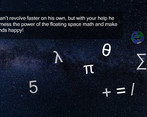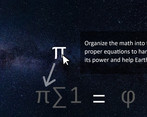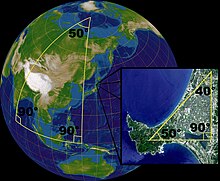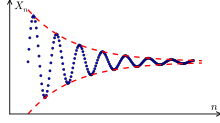Play game
R E v o l v e's itch.io pageResults
| Criteria | Rank | Score* | Raw Score |
| Gameplay | #4 | 3.733 | 3.733 |
| Sound | #7 | 3.333 | 3.333 |
| Overall | #8 | 3.450 | 3.450 |
| Aesthetics | #11 | 3.800 | 3.800 |
| Theme | #25 | 2.933 | 2.933 |
Ranked from 15 ratings. Score is adjusted from raw score by the median number of ratings per game in the jam.
Leave a comment
Log in with itch.io to leave a comment.









Comments
very charming and wholesome concept, I like how you exploit the arcane feels of math
lovely art, though the main gameplay could use some extra juice. It'd also be really satisfying to be able to use the keyboard somehow, idk
the amount of little details for what the game actually is is charming and lovely.
the gameplay could use a little more "oompf" or reward but all in all a great game.
nice submission.
Funny concept but why math ? xD
How else would you plan to increase the rotational velocity of a sextillion ton celestial body?
With magic !
What do you think math is?
Teach me math
Mathematics is an area of knowledge that includes the topics of numbers, formulas and related structures, shapes and the spaces in which they are contained, and quantities and their changes. These topics are represented in modern mathematics with the major subdisciplines of number theory, algebra, geometry, and analysis, respectively. There is no general consensus among mathematicians about a common definition for their academic discipline.
Most mathematical activity involves the discovery of properties of abstract objects and the use of pure reason to prove them. These objects consist of either abstractions from nature or—in modern mathematics—entities that are stipulated to have certain properties, called axioms. A proof consists of a succession of applications of deductive rules to already established results. These results include previously proved theorems, axioms, and—in case of abstraction from nature—some basic properties that are considered true starting points of the theory under consideration.
Mathematics is essential in the natural sciences, engineering, medicine, finance, computer science and the social sciences. Although mathematics is extensively used for modeling phenomena, the fundamental truths of mathematics are independent from any scientific experimentation. Some areas of mathematics, such as statistics and game theory, are developed in close correlation with their applications and are often grouped under applied mathematics. Other areas are developed independently from any application (and are therefore called pure mathematics), but often later find practical applications. The problem of integer factorization, for example, which goes back to Euclid in 300 BC, had no practical application before its use in the RSA cryptosystem, now widely used for the security of computer networks.
Historically, the concept of a proof and its associated mathematical rigour first appeared in Greek mathematics, most notably in Euclid's Elements. Since its beginning, mathematics was essentially divided into geometry and arithmetic (the manipulation of natural numbers and fractions), until the 16th and 17th centuries, when algebra<a]<="" a=""> and infinitesimal calculus were introduced as new areas. Since then, the interaction between mathematical innovations and scientific discoveries has led to a rapid lockstep increase in the development of both. At the end of the 19th century, the foundational crisis of mathematics led to the systematization of the axiomatic method, which heralded a dramatic increase in the number of mathematical areas and their fields of application. The contemporary Mathematics Subject Classification lists more than 60 first-level areas of mathematics.
</a]<="">
Etymology
The word mathematics comes from Ancient Greek máthēma (μάθημα), meaning "that which is learnt", "what one gets to know", hence also "study" and "science". The word came to have the narrower and more technical meaning of "mathematical study" even in Classical times. Its adjective is mathēmatikós (μαθηματικός), meaning "related to learning" or "studious", which likewise further came to mean "mathematical". In particular, mathēmatikḗ tékhnē (μαθηματικὴ τέχνη; Latin: ars mathematica) meant "the mathematical art".
Similarly, one of the two main schools of thought in Pythagoreanism was known as the mathēmatikoi (μαθηματικοί)—which at the time meant "learners" rather than "mathematicians" in the modern sense. The Pythagoreans were likely the first to constrain the use of the word to just the study of arithmetic and geometry. By the time of Aristotle (384–322 BC) this meaning was fully established.
In Latin, and in English until around 1700, the term mathematics more commonly meant "astrology" (or sometimes "astronomy") rather than "mathematics"; the meaning gradually changed to its present one from about 1500 to 1800. This change has resulted in several mistranslations: For example, Saint Augustine's warning that Christians should beware of mathematici, meaning "astrologers", is sometimes mistranslated as a condemnation of mathematicians.
The apparent plural form in English goes back to the Latin neuter plural mathematica (Cicero), based on the Greek plural ta mathēmatiká (τὰ μαθηματικά) and means roughly "all things mathematical", although it is plausible that English borrowed only the adjective mathematic(al) and formed the noun mathematics anew, after the pattern of physics and metaphysics, inherited from Greek. In English, the noun mathematics takes a singular verb. It is often shortened to maths or, in North America, math.
Areas of mathematics
Before the Renaissance, mathematics was divided into two main areas: arithmetic—regarding the manipulation of numbers, and geometry, regarding the study of shapes. Some types of pseudoscience, such as numerology and astrology, were not then clearly distinguished from mathematics.
During the Renaissance, two more areas appeared. Mathematical notation led to algebra which, roughly speaking, consists of the study and the manipulation of formulas. Calculus, consisting of the two subfields differential calculus and integral calculus, is the study of continuous functions, which model the typically nonlinear relationships between varying quantities, as represented by variables. This division into four main areas–arithmetic, geometry, algebra, calculus–endured until the end of the 19th century. Areas such as celestial mechanics and solid mechanics were then studied by mathematicians, but now are considered as belonging to physics. The subject of combinatorics has been studied for much of recorded history, yet did not become a separate branch of mathematics until the seventeenth century.
At the end of the 19th century, the foundational crisis in mathematics and the resulting systematization of the axiomatic method led to an explosion of new areas of mathematics. The 2020 Mathematics Subject Classification contains no less than sixty-three first-level areas. Some of these areas correspond to the older division, as is true regarding number theory (the modern name for higher arithmetic) and geometry. Several other first-level areas have "geometry" in their names or are otherwise commonly considered part of geometry. Algebra and calculus do not appear as first-level areas but are respectively split into several first-level areas. Other first-level areas emerged during the 20th century or had not previously been considered as mathematics, such as mathematical logic and foundations.
Number theory
Main article: Number theory

This is the Ulam spiral, which illustrates the distribution of prime numbers. The dark diagonal lines in the spiral hint at the hypothesized approximate independence between being prime and being a value of a quadratic polynomial, a conjecture now known as Hardy and Littlewood's Conjecture F.
Number theory began with the manipulation of numbers, that is, natural numbers ( N ) , and later expanded to integers ( Z )
and later expanded to integers ( Z )  and rational numbers ( Q ) .
and rational numbers ( Q ) .  Number theory was once called arithmetic, but nowadays this term is mostly used for numerical calculations. Number theory dates back to ancient Babylon and probably China. Two prominent early number theorists were Euclid of ancient Greece and Diophantus of Alexandria. The modern study of number theory in its abstract form is largely attributed to Pierre de Fermat and Leonhard Euler. The field came to full fruition with the contributions of Adrien-Marie Legendre and Carl Friedrich Gauss.
Number theory was once called arithmetic, but nowadays this term is mostly used for numerical calculations. Number theory dates back to ancient Babylon and probably China. Two prominent early number theorists were Euclid of ancient Greece and Diophantus of Alexandria. The modern study of number theory in its abstract form is largely attributed to Pierre de Fermat and Leonhard Euler. The field came to full fruition with the contributions of Adrien-Marie Legendre and Carl Friedrich Gauss.
Many easily stated number problems have solutions that require sophisticated methods, often from across mathematics. A prominent example is Fermat's Last Theorem. This conjecture was stated in 1637 by Pierre de Fermat, but it was proved only in 1994 by Andrew Wiles, who used tools including scheme theory from algebraic geometry, category theory, and homological algebra. Another example is Goldbach's conjecture, which asserts that every even integer greater than 2 is the sum of two prime numbers. Stated in 1742 by Christian Goldbach, it remains unproven despite considerable effort.
Number theory includes several subareas, including analytic number theory, algebraic number theory, geometry of numbers (method oriented), diophantine equations, and transcendence theory (problem oriented).
Geometry
Main article: Geometry

On the surface of a sphere, Euclidian geometry only applies as a local approximation. For larger scales the sum of the angles of a triangle is not equal to 180°.
Geometry is one of the oldest branches of mathematics. It started with empirical recipes concerning shapes, such as lines, angles and circles, which were developed mainly for the needs of surveying and architecture, but has since blossomed out into many other subfields.
A fundamental innovation was the ancient Greeks' introduction of the concept of proofs, which require that every assertion must be proved. For example, it is not sufficient to verify by measurement that, say, two lengths are equal; their equality must be proven via reasoning from previously accepted results (theorems) and a few basic statements. The basic statements are not subject to proof because they are self-evident (postulates), or are part of the definition of the subject of study (axioms). This principle, foundational for all mathematics, was first elaborated for geometry, and was systematized by Euclid around 300 BC in his book Elements.
The resulting Euclidean geometry is the study of shapes and their arrangements constructed from lines, planes and circles in the Euclidean plane (plane geometry) and the three-dimensional Euclidean space.
Euclidean geometry was developed without change of methods or scope until the 17th century, when René Descartes introduced what is now called Cartesian coordinates. This constituted a major change of paradigm: Instead of defining real numbers as lengths of line segments (see number line), it allowed the representation of points using their coordinates, which are numbers. Algebra (and later, calculus) can thus be used to solve geometrical problems. Geometry was split into two new subfields: synthetic geometry, which uses purely geometrical methods, and analytic geometry, which uses coordinates systemically.
Analytic geometry allows the study of curves unrelated to circles and lines. Such curves can be defined as the graph of functions, the study of which led to differential geometry. They can also be defined as implicit equations, often polynomial equations (which spawned algebraic geometry). Analytic geometry also makes it possible to consider Euclidean spaces of higher than three dimensions.
In the 19th century, mathematicians discovered non-Euclidean geometries, which do not follow the parallel postulate. By questioning that postulate's truth, this discovery has been viewed as joining Russell's paradox in revealing the foundational crisis of mathematics. This aspect of the crisis was solved by systematizing the axiomatic method, and adopting that the truth of the chosen axioms is not a mathematical problem. In turn, the axiomatic method allows for the study of various geometries obtained either by changing the axioms or by considering properties that do not change under specific transformations of the space.
Today's subareas of geometry include:
Algebra
Main article: Algebra

The quadratic formula, which concisely expresses the solutions of all quadratic equations
The Rubik's Cube group is a concrete application of group theory
Algebra is the art of manipulating equations and formulas. Diophantus (3rd century) and al-Khwarizmi (9th century) were the two main precursors of algebra. Diophantus solved some equations involving unknown natural numbers by deducing new relations until he obtained the solution. Al-Khwarizmi introduced systematic methods for transforming equations, such as moving a term from one side of an equation into the other side. The term algebra is derived from the Arabic word al-jabr meaning 'the reunion of broken parts' that he used for naming one of these methods in the title of his main treatise.
Algebra became an area in its own right only with François Viète (1540–1603), who introduced the use of variables for representing unknown or unspecified numbers. Variables allow mathematicians to describe the operations that have to be done on the numbers represented using mathematical formulas.
Until the 19th century, algebra consisted mainly of the study of linear equations (presently linear algebra), and polynomial equations in a single unknown, which were called algebraic equations (a term still in use, although it may be ambiguous). During the 19th century, mathematicians began to use variables to represent things other than numbers (such as matrices, modular integers, and geometric transformations), on which generalizations of arithmetic operations are often valid. The concept of algebraic structure addresses this, consisting of a set whose elements are unspecified, of operations acting on the elements of the set, and rules that these operations must follow. The scope of algebra thus grew to include the study of algebraic structures. This object of algebra was called modern algebra or abstract algebra, as established by the influence and works of Emmy Noether. (The latter term appears mainly in an educational context, in opposition to elementary algebra, which is concerned with the older way of manipulating formulas.)
Some types of algebraic structures have useful and often fundamental properties, in many areas of mathematics. Their study became autonomous parts of algebra, and include:
The study of types of algebraic structures as mathematical objects is the purpose of universal algebra and category theory. The latter applies to every mathematical structure (not only algebraic ones). At its origin, it was introduced, together with homological algebra for allowing the algebraic study of non-algebraic objects such as topological spaces; this particular area of application is called algebraic topology.
Calculus and analysis
Main articles: Calculus and Mathematical analysis

A Cauchy sequence consists of elements that become arbitrarily close to each other as the sequence progresses (from left to right).
Calculus, formerly called infinitesimal calculus, was introduced independently and simultaneously by 17th-century mathematicians Newton and Leibniz. It is fundamentally the study of the relationship of variables that depend on each other. Calculus was expanded in the 18th century by Euler with the introduction of the concept of a function and many other results. Presently, "calculus" refers mainly to the elementary part of this theory, and "analysis" is commonly used for advanced parts.
Analysis is further subdivided into real analysis, where variables represent real numbers, and complex analysis, where variables represent complex numbers. Analysis includes many subareas shared by other areas of mathematics which include:
Discrete mathematics
Main article: Discrete mathematics

A diagram representing a two-state Markov chain. The states are represented by 'A' and 'E'. The numbers are the probability of flipping the state.
Discrete mathematics, broadly speaking, is the study of individual, countable mathematical objects. An example is the set of all integers. Because the objects of study here are discrete, the methods of calculus and mathematical analysis do not directly apply.<c]<="" a=""> Algorithms—especially their implementation and computational complexity—play a major role in discrete mathematics.</c]<="">
The four color theorem and optimal sphere packing were two major problems of discrete mathematics solved in the second half of the 20th century. The P versus NP problem, which remains open to this day, is also important for discrete mathematics, since its solution would potentially impact a large number of computationally difficult problems.
Discrete mathematics includes:
Mathematical logic and set theory
The Venn diagram is a commonly used method to illustrate the relations between sets.
Main articles: Mathematical logic and set theory
The two subjects of mathematical logic and set theory have belonged to mathematics since the end of the 19th century. Before this period, sets were not considered to be mathematical objects, and logic, although used for mathematical proofs, belonged to philosophy and was not specifically studied by mathematicians.
Before Cantor's study of infinite sets, mathematicians were reluctant to consider actually infinite collections, and considered infinity to be the result of endless enumeration. Cantor's work offended many mathematicians not only by considering actually infinite sets but by showing that this implies different sizes of infinity, per Cantor's diagonal argument. This led to the controversy over Cantor's set theory.
In the same period, various areas of mathematics concluded the former intuitive definitions of the basic mathematical objects were insufficient for ensuring mathematical rigour. Examples of such intuitive definitions are "a set is a collection of objects", "natural number is what is used for counting", "a point is a shape with a zero length in every direction", "a curve is a trace left by a moving point", etc.
This became the foundational crisis of mathematics. It was eventually solved in mainstream mathematics by systematizing the axiomatic method inside a formalized set theory. Roughly speaking, each mathematical object is defined by the set of all similar objects and the properties that these objects must have. For example, in Peano arithmetic, the natural numbers are defined by "zero is a number", "each number has a unique successor", "each number but zero has a unique predecessor", and some rules of reasoning. This mathematical abstraction from reality is embodied in the modern philosophy of formalism, as founded by David Hilbert around 1910.
The "nature" of the objects defined this way is a philosophical problem that mathematicians leave to philosophers, even if many mathematicians have opinions on this nature, and use their opinion—sometimes called "intuition"—to guide their study and proofs. The approach allows considering "logics" (that is, sets of allowed deducing rules), theorems, proofs, etc. as mathematical objects, and to prove theorems about them. For example, Gödel's incompleteness theorems assert, roughly speaking that, in every consistent formal system that contains the natural numbers, there are theorems that are true (that is provable in a stronger system), but not provable inside the system. This approach to the foundations of mathematics was challenged during the first half of the 20th century by mathematicians led by Brouwer, who promoted intuitionistic logic, which explicitly lacks the law of excluded middle.
These problems and debates led to a wide expansion of mathematical logic, with subareas such as model theory (modeling some logical theories inside other theories), proof theory, type theory, computability theory and computational complexity theory. Although these aspects of mathematical logic were introduced before the rise of computers, their use in compiler design, program certification, proof assistants and other aspects of computer science, contributed in turn to the expansion of these logical theories.
Statistics and other decision sciences
Main articles: Statistics and Probability theory

Whatever the form of a random population distribution (μ), the sampling mean (x̄) tends to a Gaussian distribution and its variance (σ) is given by the central limit theorem of probability theory.
Statistical theory studies decision problems such as minimizing the risk (expected loss) of a statistical action, such as using a procedure in, for example, parameter estimation, hypothesis testing, and selecting the best. In these traditional areas of mathematical statistics, a statistical-decision problem is formulated by minimizing an objective function, like expected loss or cost, under specific constraints. For example, designing a survey often involves minimizing the cost of estimating a population mean with a given level of confidence. Because of its use of optimization, the mathematical theory of statistics overlaps with other decision sciences, such as operations research, control theory, and mathematical economics.
Computational mathematics
Main article: Computational mathematics
Computational mathematics is the study of mathematical problems that are typically too large for human, numerical capacity. Numerical analysis studies methods for problems in analysis using functional analysis and approximation theory; numerical analysis broadly includes the study of approximation and discretization with special focus on rounding errors. Numerical analysis and, more broadly, scientific computing also study non-analytic topics of mathematical science, especially algorithmic-matrix-and-graph theory. Other areas of computational mathematics include computer algebra and symbolic computation.
Nice game, fun and difficult :) Really cool gameplay concept
Really cool game, I had fun! Feedback-wise, I noticed that you can't ever see the Intro sequence after you've hit the play button once. I even downloaded it again to see it but it wouldn't play, I'm guessing it saved a file somewhere which says that the intro has already been seen?
Also, maybe implement something to have the player play forever but lose under a condition not based on a set time limit. since the symbols appear randomly it almost feels like my score depends on chance throughout the game. Maybe I missed something on the intro though.
Nevertheless, it's really addicting to search for symbols! Good job.
Glad you liked it and thanks for the feedback! The intro sequence was handled by Unities Player-Prefs which are annoyingly persistent (also, I wasn't expecting anyone to want to see that again Lol).
While the symbols are random, there are some things behind the scenes to keep the rng from being too bad so it's not as big a factor as you'd think unless you're trying to get Really high scores.
Also, I'll put the slides from the into in the game page if you want to see them.
Yea please do! I skipped a couple I don't know what they said haha.
They should be there now
would have rate 5/5 if i could because im #1 rn WOO and bc its a good game
Interesting idea! And cool implementation of the theme
Very well done!
Quite a fun little game! The concept is quite unique, I would say, and it seems it can definitely benefit for some over the top animations to happen when you do complete an equation.
At a first glance was not expecting to enjoy it as much as I ended up, which is an awesome experience to have.
fun game
Good game
Unexpectedly fun as the RPMs rise, it took me a moment to notice the little stick figures flying off in the mix, and the flames were a nice touch!
I think a little more could have been done for game feel ( more crazy, over the top feedback when completing/building equations ), but overall was a great game that distracted me longer than I expected it would!
Really great work!
Funny take on the theme.
Really like the graphics with the extras like people flying off.
Gameplay could be a bit more exciting but is pretty fun
Nice. I like it